Yuanyuan Zhu
Can a Small Model Learn to Look Before It Leaps? Dynamic Learning and Proactive Correction for Hallucination Detection
Nov 08, 2025Abstract:Hallucination in large language models (LLMs) remains a critical barrier to their safe deployment. Existing tool-augmented hallucination detection methods require pre-defined fixed verification strategies, which are crucial to the quality and effectiveness of tool calls. Some methods directly employ powerful closed-source LLMs such as GPT-4 as detectors, which are effective but too costly. To mitigate the cost issue, some methods adopt the teacher-student architecture and finetune open-source small models as detectors via agent tuning. However, these methods are limited by fixed strategies. When faced with a dynamically changing execution environment, they may lack adaptability and inappropriately call tools, ultimately leading to detection failure. To address the problem of insufficient strategy adaptability, we propose the innovative ``Learning to Evaluate and Adaptively Plan''(LEAP) framework, which endows an efficient student model with the dynamic learning and proactive correction capabilities of the teacher model. Specifically, our method formulates the hallucination detection problem as a dynamic strategy learning problem. We first employ a teacher model to generate trajectories within the dynamic learning loop and dynamically adjust the strategy based on execution failures. We then distill this dynamic planning capability into an efficient student model via agent tuning. Finally, during strategy execution, the student model adopts a proactive correction mechanism, enabling it to propose, review, and optimize its own verification strategies before execution. We demonstrate through experiments on three challenging benchmarks that our LEAP-tuned model outperforms existing state-of-the-art methods.
Privacy-protected Retrieval-Augmented Generation for Knowledge Graph Question Answering
Aug 12, 2025Abstract:LLMs often suffer from hallucinations and outdated or incomplete knowledge. RAG is proposed to address these issues by integrating external knowledge like that in KGs into LLMs. However, leveraging private KGs in RAG systems poses significant privacy risks due to the black-box nature of LLMs and potential insecure data transmission, especially when using third-party LLM APIs lacking transparency and control. In this paper, we investigate the privacy-protected RAG scenario for the first time, where entities in KGs are anonymous for LLMs, thus preventing them from accessing entity semantics. Due to the loss of semantics of entities, previous RAG systems cannot retrieve question-relevant knowledge from KGs by matching questions with the meaningless identifiers of anonymous entities. To realize an effective RAG system in this scenario, two key challenges must be addressed: (1) How can anonymous entities be converted into retrievable information. (2) How to retrieve question-relevant anonymous entities. Hence, we propose a novel ARoG framework including relation-centric abstraction and structure-oriented abstraction strategies. For challenge (1), the first strategy abstracts entities into high-level concepts by dynamically capturing the semantics of their adjacent relations. It supplements meaningful semantics which can further support the retrieval process. For challenge (2), the second strategy transforms unstructured natural language questions into structured abstract concept paths. These paths can be more effectively aligned with the abstracted concepts in KGs, thereby improving retrieval performance. To guide LLMs to effectively retrieve knowledge from KGs, the two strategies strictly protect privacy from being exposed to LLMs. Experiments on three datasets demonstrate that ARoG achieves strong performance and privacy-robustness.
A Survey on Training-free Alignment of Large Language Models
Aug 12, 2025Abstract:The alignment of large language models (LLMs) aims to ensure their outputs adhere to human values, ethical standards, and legal norms. Traditional alignment methods often rely on resource-intensive fine-tuning (FT), which may suffer from knowledge degradation and face challenges in scenarios where the model accessibility or computational resources are constrained. In contrast, training-free (TF) alignment techniques--leveraging in-context learning, decoding-time adjustments, and post-generation corrections--offer a promising alternative by enabling alignment without heavily retraining LLMs, making them adaptable to both open-source and closed-source environments. This paper presents the first systematic review of TF alignment methods, categorizing them by stages of pre-decoding, in-decoding, and post-decoding. For each stage, we provide a detailed examination from the viewpoint of LLMs and multimodal LLMs (MLLMs), highlighting their mechanisms and limitations. Furthermore, we identify key challenges and future directions, paving the way for more inclusive and effective TF alignment techniques. By synthesizing and organizing the rapidly growing body of research, this survey offers a guidance for practitioners and advances the development of safer and more reliable LLMs.
MultiTaskDeltaNet: Change Detection-based Image Segmentation for Operando ETEM with Application to Carbon Gasification Kinetics
Jul 22, 2025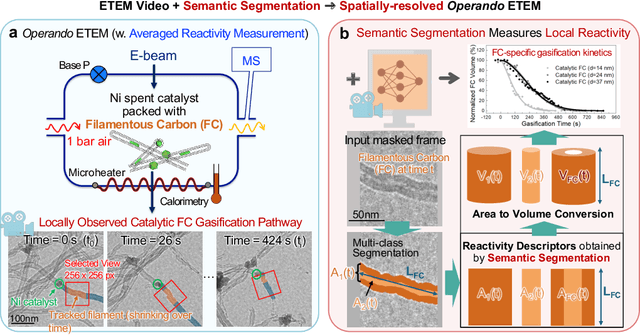
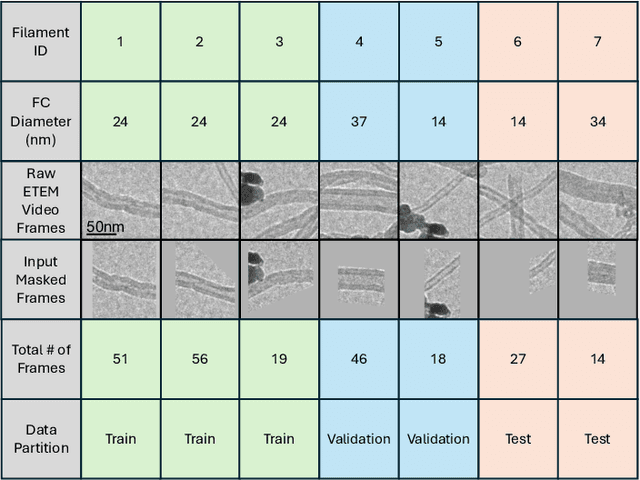

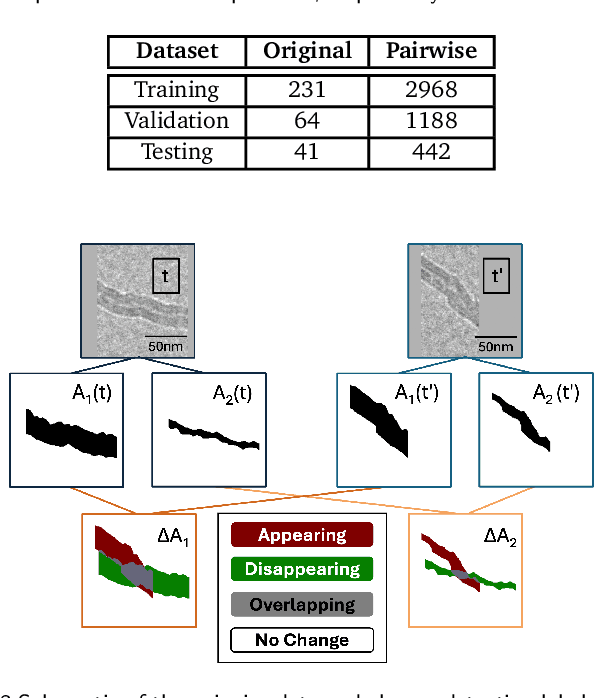
Abstract:Transforming in-situ transmission electron microscopy (TEM) imaging into a tool for spatially-resolved operando characterization of solid-state reactions requires automated, high-precision semantic segmentation of dynamically evolving features. However, traditional deep learning methods for semantic segmentation often encounter limitations due to the scarcity of labeled data, visually ambiguous features of interest, and small-object scenarios. To tackle these challenges, we introduce MultiTaskDeltaNet (MTDN), a novel deep learning architecture that creatively reconceptualizes the segmentation task as a change detection problem. By implementing a unique Siamese network with a U-Net backbone and using paired images to capture feature changes, MTDN effectively utilizes minimal data to produce high-quality segmentations. Furthermore, MTDN utilizes a multi-task learning strategy to leverage correlations between physical features of interest. In an evaluation using data from in-situ environmental TEM (ETEM) videos of filamentous carbon gasification, MTDN demonstrated a significant advantage over conventional segmentation models, particularly in accurately delineating fine structural features. Notably, MTDN achieved a 10.22% performance improvement over conventional segmentation models in predicting small and visually ambiguous physical features. This work bridges several key gaps between deep learning and practical TEM image analysis, advancing automated characterization of nanomaterials in complex experimental settings.
Exploiting Text Semantics for Few and Zero Shot Node Classification on Text-attributed Graph
May 13, 2025



Abstract:Text-attributed graph (TAG) provides a text description for each graph node, and few- and zero-shot node classification on TAGs have many applications in fields such as academia and social networks. Existing work utilizes various graph-based augmentation techniques to train the node and text embeddings, while text-based augmentations are largely unexplored. In this paper, we propose Text Semantics Augmentation (TSA) to improve accuracy by introducing more text semantic supervision signals. Specifically, we design two augmentation techniques, i.e., positive semantics matching and negative semantics contrast, to provide more reference texts for each graph node or text description. Positive semantic matching retrieves texts with similar embeddings to match with a graph node. Negative semantic contrast adds a negative prompt to construct a text description with the opposite semantics, which is contrasted with the original node and text. We evaluate TSA on 5 datasets and compare with 13 state-of-the-art baselines. The results show that TSA consistently outperforms all baselines, and its accuracy improvements over the best-performing baseline are usually over 5%.
Toxicity Detection towards Adaptability to Changing Perturbations
Dec 17, 2024Abstract:Toxicity detection is crucial for maintaining the peace of the society. While existing methods perform well on normal toxic contents or those generated by specific perturbation methods, they are vulnerable to evolving perturbation patterns. However, in real-world scenarios, malicious users tend to create new perturbation patterns for fooling the detectors. For example, some users may circumvent the detector of large language models (LLMs) by adding `I am a scientist' at the beginning of the prompt. In this paper, we introduce a novel problem, i.e., continual learning jailbreak perturbation patterns, into the toxicity detection field. To tackle this problem, we first construct a new dataset generated by 9 types of perturbation patterns, 7 of them are summarized from prior work and 2 of them are developed by us. We then systematically validate the vulnerability of current methods on this new perturbation pattern-aware dataset via both the zero-shot and fine tuned cross-pattern detection. Upon this, we present the domain incremental learning paradigm and the corresponding benchmark to ensure the detector's robustness to dynamically emerging types of perturbed toxic text. Our code and dataset are provided in the appendix and will be publicly available at GitHub, by which we wish to offer new research opportunities for the security-relevant communities.
Origin-Destination Demand Prediction: An Urban Radiation and Attraction Perspective
Nov 29, 2024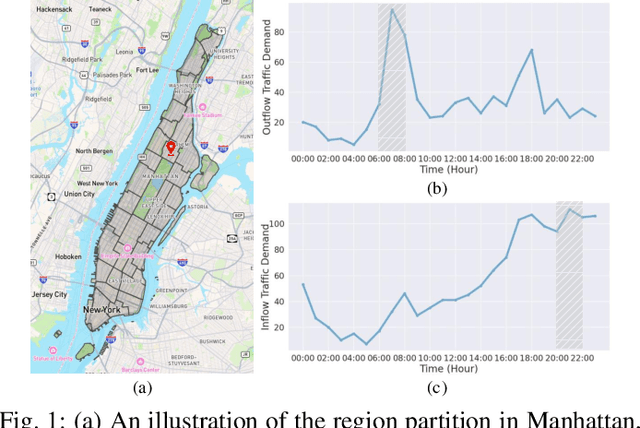
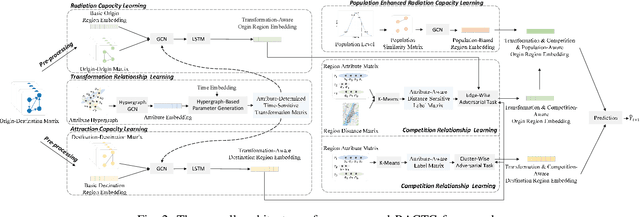
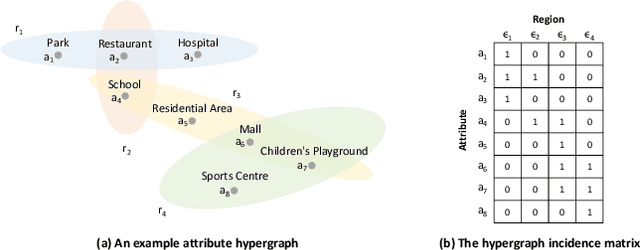

Abstract:In recent years, origin-destination (OD) demand prediction has gained significant attention for its profound implications in urban development. Existing data-driven deep learning methods primarily focus on the spatial or temporal dependency between regions yet neglecting regions' fundamental functional difference. Though knowledge-driven physical methods have characterised regions' functions by their radiation and attraction capacities, these functions are defined on numerical factors like population without considering regions' intrinsic nominal attributes, e.g., a region is a residential or industrial district. Moreover, the complicated relationships between two types of capacities, e.g., the radiation capacity of a residential district in the morning will be transformed into the attraction capacity in the evening, are totally missing from physical methods. In this paper, we not only generalize the physical radiation and attraction capacities into the deep learning framework with the extended capability to fulfil regions' functions, but also present a new model that captures the relationships between two types of capacities. Specifically, we first model regions' radiation and attraction capacities using a bilateral branch network, each equipped with regions' attribute representations. We then describe the transformation relationship of different capacities of the same region using a hypergraph-based parameter generation method. We finally unveil the competition relationship of different regions with the same attraction capacity through cluster-based adversarial learning. Extensive experiments on two datasets demonstrate the consistent improvements of our method over the state-of-the-art baselines, as well as the good explainability of regions' functions using their nominal attributes.
Hound: Hunting Supervision Signals for Few and Zero Shot Node Classification on Text-attributed Graph
Sep 01, 2024



Abstract:Text-attributed graph (TAG) is an important type of graph structured data with text descriptions for each node. Few- and zero-shot node classification on TAGs have many applications in fields such as academia and social networks. However, the two tasks are challenging due to the lack of supervision signals, and existing methods only use the contrastive loss to align graph-based node embedding and language-based text embedding. In this paper, we propose Hound to improve accuracy by introducing more supervision signals, and the core idea is to go beyond the node-text pairs that come with data. Specifically, we design three augmentation techniques, i.e., node perturbation, text matching, and semantics negation to provide more reference nodes for each text and vice versa. Node perturbation adds/drops edges to produce diversified node embeddings that can be matched with a text. Text matching retrieves texts with similar embeddings to match with a node. Semantics negation uses a negative prompt to construct a negative text with the opposite semantics, which is contrasted with the original node and text. We evaluate Hound on 5 datasets and compare with 13 state-of-the-art baselines. The results show that Hound consistently outperforms all baselines, and its accuracy improvements over the best-performing baseline are usually over 5%.
Cross-Domain Separable Translation Network for Multimodal Image Change Detection
Jul 23, 2024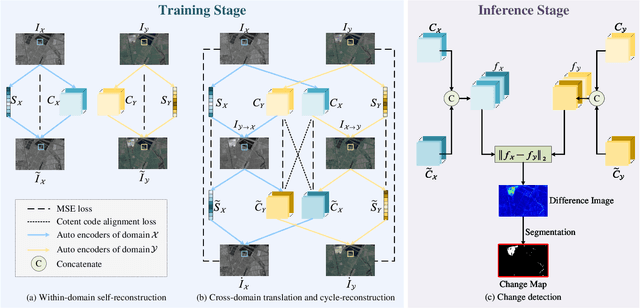
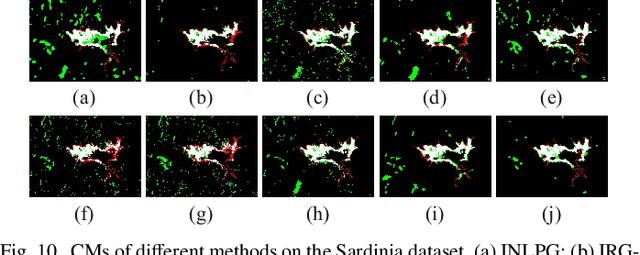
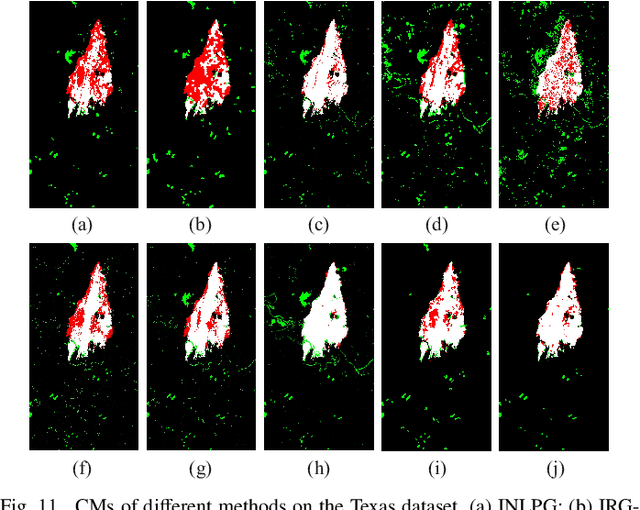
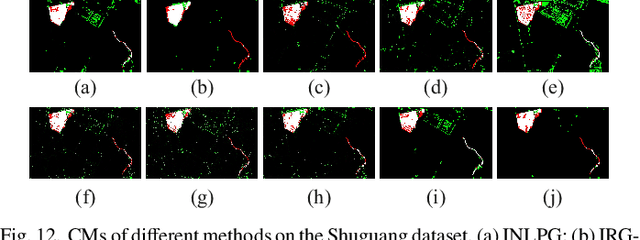
Abstract:In the remote sensing community, multimodal change detection (MCD) is particularly critical due to its ability to track changes across different imaging conditions and sensor types, making it highly applicable to a wide range of real-world scenarios. This paper focuses on addressing the challenges of MCD, especially the difficulty in comparing images from different sensors with varying styles and statistical characteristics of geospatial objects. Traditional MCD methods often struggle with these variations, leading to inaccurate and unreliable results. To overcome these limitations, a novel unsupervised cross-domain separable translation network (CSTN) is proposed, which uniquely integrates a within-domain self-reconstruction and a cross-domain image translation and cycle-reconstruction workflow with change detection constraints. The model is optimized by implementing both the tasks of image translation and MCD simultaneously, thereby guaranteeing the comparability of learned features from multimodal images. Specifically, a simple yet efficient dual-branch convolutional architecture is employed to separate the content and style information of multimodal images. This process generates a style-independent content-comparable feature space, which is crucial for achieving accurate change detection even in the presence of significant sensor variations. Extensive experimental results demonstrate the effectiveness of the proposed method, showing remarkable improvements over state-of-the-art approaches in terms of accuracy and efficacy for MCD. The implementation of our method will be publicly available at \url{https://github.com/OMEGA-RS/CSTN}
Weaver: Foundation Models for Creative Writing
Jan 30, 2024

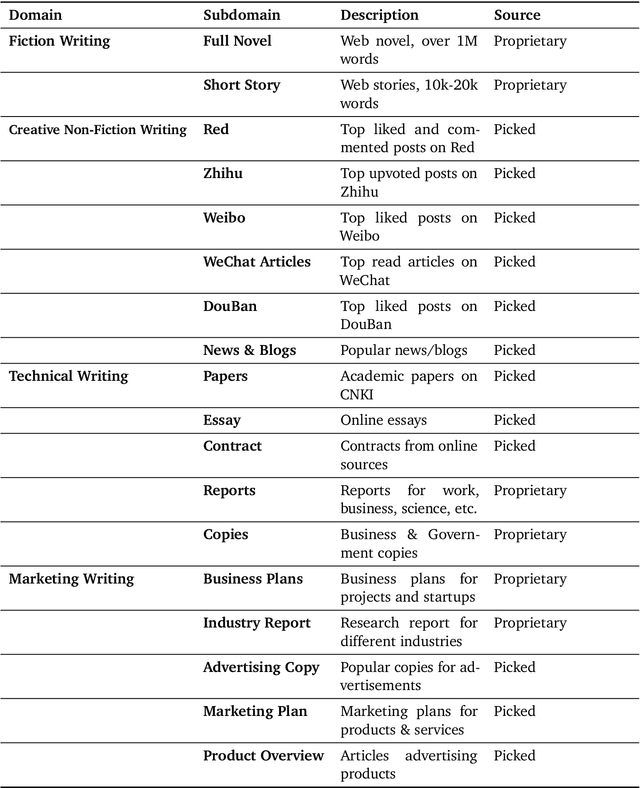

Abstract:This work introduces Weaver, our first family of large language models (LLMs) dedicated to content creation. Weaver is pre-trained on a carefully selected corpus that focuses on improving the writing capabilities of large language models. We then fine-tune Weaver for creative and professional writing purposes and align it to the preference of professional writers using a suit of novel methods for instruction data synthesis and LLM alignment, making it able to produce more human-like texts and follow more diverse instructions for content creation. The Weaver family consists of models of Weaver Mini (1.8B), Weaver Base (6B), Weaver Pro (14B), and Weaver Ultra (34B) sizes, suitable for different applications and can be dynamically dispatched by a routing agent according to query complexity to balance response quality and computation cost. Evaluation on a carefully curated benchmark for assessing the writing capabilities of LLMs shows Weaver models of all sizes outperform generalist LLMs several times larger than them. Notably, our most-capable Weaver Ultra model surpasses GPT-4, a state-of-the-art generalist LLM, on various writing scenarios, demonstrating the advantage of training specialized LLMs for writing purposes. Moreover, Weaver natively supports retrieval-augmented generation (RAG) and function calling (tool usage). We present various use cases of these abilities for improving AI-assisted writing systems, including integration of external knowledge bases, tools, or APIs, and providing personalized writing assistance. Furthermore, we discuss and summarize a guideline and best practices for pre-training and fine-tuning domain-specific LLMs.
 Add to Chrome
Add to Chrome Add to Firefox
Add to Firefox Add to Edge
Add to Edge